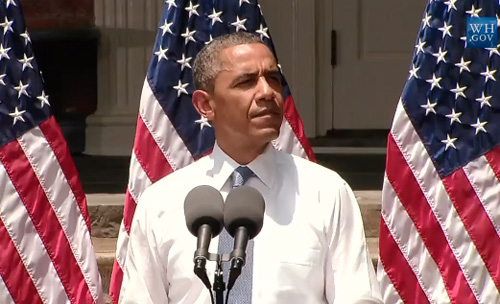
"We need to act."
With those words Tuesday afternoon, President Obama took an important step toward turning his pledges on climate change into reality.
February's State of the Union address put climate change back on the national agenda. Tuesday's speech was another welcome recognition that climate change is here, is an acute risk to human well-being and demands bold action now.
And, just as important, the president acknowledged that when it comes to boosting the economy and fighting climate change, it's not an "either/or." It's a "both/and."
The president's plan creates a roadmap for America's leadership on climate change in several important areas.
First, it lays the path limiting greenhouse gas emissions from existing power plants. U.S. electric power plants emit 2.2 billion tons of CO2 annually -- 40 percent of the nation's carbon dioxide emissions. Tackling the largest source of the problem first is a smart move, one that can put a significant dent in emissions relatively quickly.
Limiting power plant emissions is also a cost-efficient move. With domestic sources of low- and no-carbon energy becoming more abundant and less expensive, we have the opportunity to achieve substantial reductions in overall emissions at relatively low cost.
Over the past 35 years, the EPA has used the Clean Air Act to effectively reduce pollution that endangers public health and welfare, including vehicle emissions. The same authority can and should be used to put in place carbon pollution standards for new and existing power plants. Failure to act decisively on this major source of emissions would far outweigh the costs of addressing the issue now.
Second, the president's plan calls for promoting renewable energy development on public lands. When done in the right way and in the right places, such development can be an important part of the equation for reducing emissions.
In making permitting decisions regarding major infrastructure projects, we should be evaluating likely contributions to greenhouse gas emissions, in addition to land, water and habitat impacts. It appears that the Administration is approaching the Keystone XL pipeline decision with this in mind. This is a sound approach.
Finally, it was encouraging to hear the president call for increased energy efficiency standards for appliances. Cutting energy waste is the least-cost way of reducing carbon emissions.
While these are important steps to address the root causes of climate change, we also need a comprehensive plan for addressing the reality of the changes we are already seeing, from sea level rise to more severe and erratic weather patterns that result in increased storms, heat waves, floods and droughts.
Here, I was especially encouraged by the president's plan to make our farms, forests and coasts more resilient. The plan directs federal agencies to make more climate resilient investments that explicitly consider climate change impacts and to remove federal barriers to making those investments. Whenever and wherever possible, we should invest in natural defenses such as the protection of natural floodplains, healthy forests, and the restoration of coastal features like oyster reefs, marshes, sand dunes and wetlands that act as buffers to waves and higher tides. These natural defenses are often more durable and cost-effective than traditional infrastructure. They are a smart investment that will save government money in the long-run.
While it is encouraging to see the president taking executive action to address the challenge of climate change, several future steps would put us even further along the path to a comprehensive solution. These include putting a price on carbon; conserving forests and keeping the carbon they store out of the atmosphere by reducing deforestation; investing in research and development that can lead to discoveries applicable in other countries like China and India; and showing bold leadership—and follow-through—on international climate change negotiations.
Taken together, these steps chart a comprehensive course for America's leadership on addressing climate change. It is now important to establish the decisive goals and measures that will make this plan reality, and it is now up to all of us -- the president, Congress, and the American people -- to translate his plan to action on the ground across the U.S. and around the world.
[Image: The president speaks on his plan to reduce carbon pollution. Image source: whitehouse.gov]
